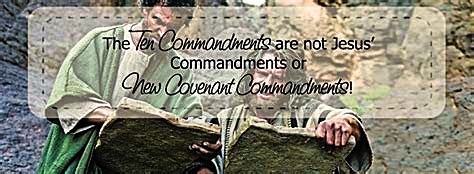New Covenant Ways – BT2b: The New Covenant is absolutely ‘NEW,’ so nothing like the old and worn-out

New Covenant Ways – BT2b: The New Covenant is absolutely ‘NEW,’ so nothing like the old and worn-out
Please follow the BLOG Etiquette to stay on topic and pass the moderator’s check. Bold, underlined text below = future links to the BLOG pages.
Again, every time God wants to emphasize that something is “NEW” not just in time, as with “younger” translated from the Hebrew tsa’iyr or the Greek neos, but instead “fresh, completely-different-in-kind, unprecedented, sharing nothing with its predecessors, unique, and superior,” then God uses the Hebrew chadash or Greek kainos. Absolutely nothing is carried from the old (previous) into the NEW (current) by definition, just as an invention can’t “borrow” from previous inventions in order to be lawfully patented. In mathematical set theory, the two circles/spheres don’t even touch let alone overlap to create a union! We saw this in New Covenant Ways – BT2.
God also frequently uses the double absolute negatives ou ou or ou me, or just ou to express absolute prohibition, something few bibles translate correctly – see Bible Info, but I always insert the word “absolutely in fact absolutely, absolutely in fact and in possibility, or just absolutely in fact,” respectively, to indicate this. Also as we’ve seen, when God says something is “palaios old” like the “old covenant,” He doesn’t just mean “old, dated, or ancient in time,” but also that it is “worn out by use, having suffered more or less from the injuries and ravages of time, thus worse for wear, even obsolete.”
One of the biggest problems in the Church’s teaching is not understanding the absolute difference between the NEW and old covenants. All the NT writers battled against this! Legalistic Christians and churches are always trying to drag something over from the “ancient and worn out” into the “fresh, completely-different-in-kind, unprecedented, and superior.” The NT isn’t “Part 2” of God’s OT “Part 1” plan of God – it’s a radical diversion from it! We must thoroughly understand this! Otherwise, “borrowing” from the OT is exactly the foundational problem of The Great Wall quenching the Holy Spirit in the Church.
So many Christians are trying to mix the old covenant’s “Law of commandments for righteousness” that earn, merit, or deserve God’s conditionally-loving favor by their own obedience to His explicitly-stated conditions of the New Covenant’s gospel logos message (a) of unearned, unmerited, and undeserved unconditional-loving-favor-of-grace that is received solely by trusting-relying-faith (b). However, water and oil will never mix no matter how much you try to mix them together! You can’t mix the bad news of “the Law of sin, judgment, and death” (c) with the “Great News of the gospel” – they are polar opposites! One is the problem and the other is the solution! As we will see, Jesus said trying to “put the NEW wine into old wineskins” or “trying to sew new cloth onto an old garment” only ruins both – see New Covenant Ways – BT7. <Notes> a) means ‘Great News,’ b) pistis: relational conviction of trusting reliance, c) Romans 2:12, 27; 8:2
And the context of “NEW wine in old wineskins” in Matthew 9:14-17, Mark 2:18-22, and Luke 5:33-38 was about the OT practice of “fasting,” which Jesus and His disciples no longer practiced. Sure Jesus said, they would indeed fast, but the context of that is the short period of “mourning” after His death, for fasting was a common practice during mourning. Believe me, when Christ ascended, they was no longer any need for fasting! Then why do many churches and Christians still fast? To follow OT rules of holiness? To follow rabbinical teaching of holiness? To mourn Christ’s death again? Shouldn’t we be more like the disciples who were eating and drinking with Jesus?
If you examine ancient manuscripts closely (a), you will see many verses about “proseuche conversational-prayer” in the oldest, most reliable manuscripts that have nothing to do with “fasting,” but then we see the word “fasting” added into later manuscripts after the Catholic Church started pulling in more and more OT rituals to justify their corruption of Christianity. Many Catholic theologians readily embraced Greek philosophies that espoused fasting as a religious discipline (b). There is no mention of early Church fasting except in the very earliest Jewish stages, which is a carry over from Levitical ordination (c). <Notes> a) that’s what textual criticism does, b) Colossians 2:18, 23, c) Acts 13:2-3, 14:23.
Reflection:
Why are Christians violating the very differences between covenants by trying to mix them? Don’t they know that both covenants will be ruined by this? Why are we having anything to do with what is “worn-out and obsolete,” when we have what is “superior?”
Prayer:
Lord, keep us from ever watering down the pure, perfect, holy, righteous GREAT NEWS of the gospel with anything that came before it!
Spiritual Education, New Covenant is completely different in kind so absolutely nothing like the Old Covenant, The New Covenant shares nothing with the Old Covenant, The New Covenant is superior to the Old Covenant, Mixing the covenants is false teaching legalism quenching the Spirit, Mixing covenants ruins both, New wine in old wineskins ruins both, Grace and Law can’t mix because they are opposites, Law is the problem but Grace the solution, fasting was added to praying by Catholics, fasting is part of the Law and Jewish traditions, fasting is part of the old wineskins, New Wine is the Spirit and blood of Jesus


